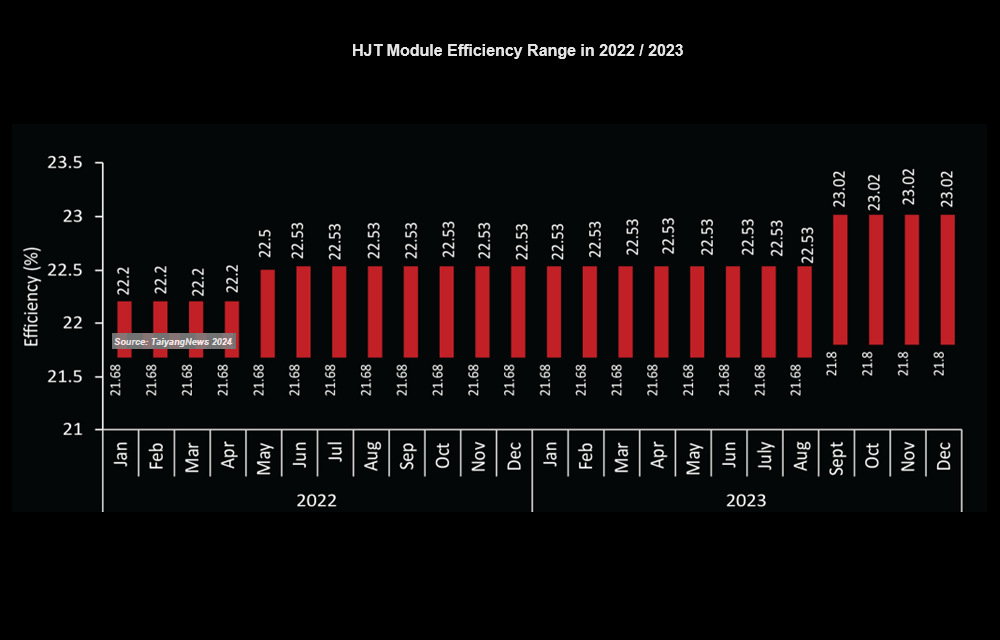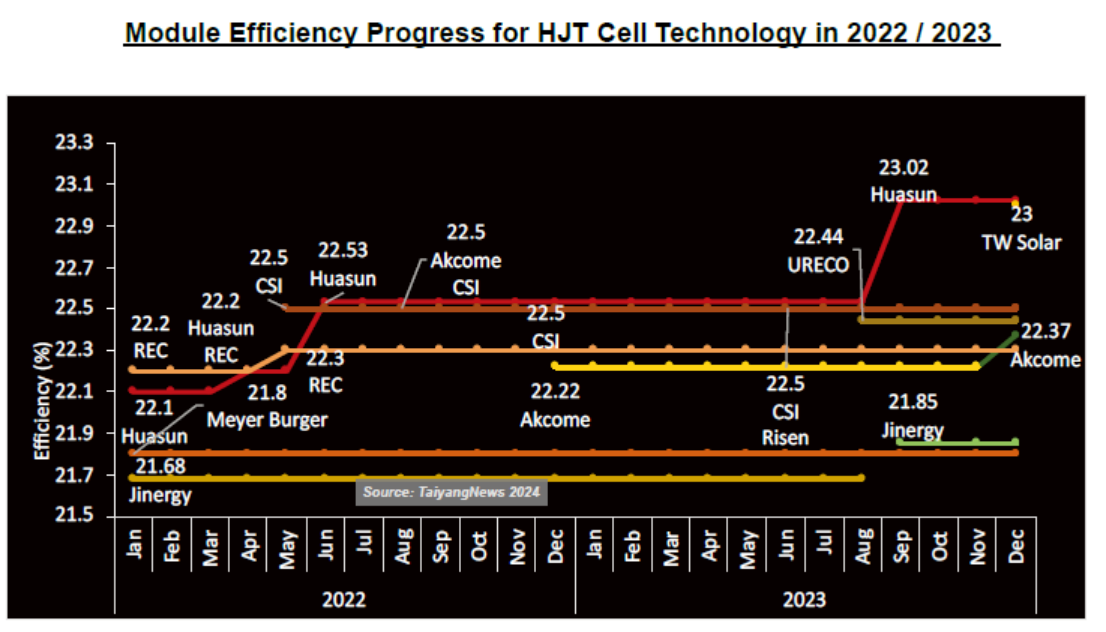
Ascent in top efficiencies: Within the efficiency range of HJT, compared to the lower limit, which changed only once from 21.68% to 21.6%, the upper limit saw several improvements – from 22.2% to 22.5%, then 22.53% and 23.02%. (Source: TaiyangNews)
●Throughout 2022 and a major part of 2023, the lower efficiency limit for HJT modules remained steady at 21.68%, with Jinergy representing this threshold until August 2023
●The upper limit of HJT module efficiency fluctuated, reaching 22.2% in April 2022, 22.5% in May, and exceeding 23% in September 2023
●Huasun’s Himalaya module stands 1st among the HJT modules with an efficiency of 23.02%.
TaiyangNews tracks the efficiency of commercial PV modules monthly since 2022, prioritizing efficiency as a key factor. The Top Solar Modules analysis report from TaiyangNews provides a summary of these findings. Our previous articles in the technology category have featured insights from this report. Our most recent article delved into the efficiency of solar modules utilizing the Interdigitated Back Contact (IBC) technology.
For HJT, the lower limit of 21.68% was maintained throughout 2022 and a major part of 2023, before it changed once – increasing to 21.8% in August. The January 2022 upper limit of 21.9% was bettered in February to reach 22.2%, which remained the case till April. It then increased to 22.5% in May, and again improved marginally to 22.53% in July 2022. It exceeded the 23% level in September 2023, when 23.02% was reached, and remained so until the end of the year.
As for the companies, REC held the top spot at 22.2% until March 2022. Then in April, Huasun, the HJT segment pioneer that had been promoting a 22.1% HJT module, commercialized an HJT product with 22.2% efficiency, sharing the top space with REC. In May 2022, Canadian Solar entered the list with a 22.5% product, pushing REC down to 2nd place with its 22.3% efficiency HJT module, which itself had increased from 22.2%. The very next month, Huasun commercialized its new HJT module with 22.53%, which remained the top efficiency until August 2023. In September, Huasun bettered itself by commercializing a module with 23.02% efficiency, which not only took HJT beyond the 23% level but also earned it a place among the top 3 ranks in our list. Huasun continued its lead till the end of 2023.
REC and Canadian Solar also maintained the efficiencies of their HJT products at the same level during the period, at 22.3% and 22.5%. In June 2022, Akcome entered our listing as an HJT maker with a 22.5% efficient module, which remained the same until October 2022, while the product specs became inaccessible in November. In December 2022, Akcome released a new HJT module; however, with a lower efficiency of 22.22%. Exactly after 1 year, in December 2023, the company improved it to 22.37%. The HJT product of longtime HJT proponent Risen featured for the first time in our list in April 2023 with an efficiency of 22.5%, the same as Canadian Solar’s product, both of which were not altered till the end of 2023. In August 2023, URECO joined the list with 22.44% efficiency, which continued to be so till the end of the year. Our December 2023 edition included the HJT module from Tongwei for the first time with an impressive 23% efficiency.

Crossing the 23% barrier: One of the most prominent changes in the HJT segment was Huasun commercializing a module with 23.02% efficiency in September 2023, earning it a place in the top 3 on our list (Source: TaiyangNews).
Meyer Burger, a Germany based HJT manufacturer using its own proprietary cell and module production equipment, maintained the same module efficiency of 21.8% throughout our TOP MODULES coverage. Jinergy’s HJT module represented the lower limit of HJT modules at 21.68% from the beginning of 2022 until August 2023. In September, the company commercialized a module with improved efficiency of 21.85%, pushing Meyer Burger’s product to the lowest level in this segment.